Remington 870 Vang Comp Systems Magazine Extension Tube Review
Thanks to Synchronizor for this review.
Founded in 1990 by gunsmith Hans Vang, Vang Comp Systems, Inc. offers a variety of gunsmithing and refinishing services, but is perhaps best known for the system of barrel modifications that they offer for combat shotguns. The company also produces a handful of tactical shotgun parts and accessories, including a line of magazine extensions. Vang Comp’s shotgun accessories have an overall positive reputation across the shotgunning community for quality and durability, and their Remington magazine extensions, offered in +1 and +2 varieties, are popular choices for combat and defensive 870 builds. They are also notably used on Nighthawk’s extremely high-dollar custom combat 870s.
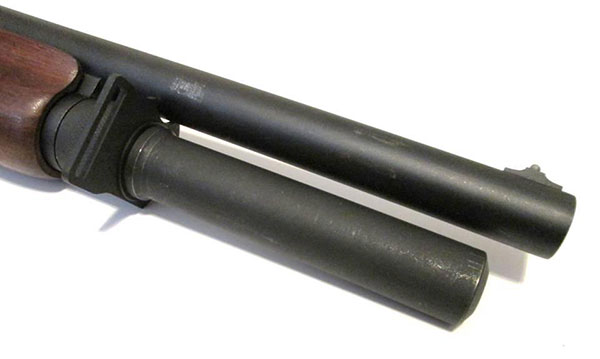
Remington 870 Vang Comp Systems Magazine Extension Tube
Cost:
I’ll start with price, because that plays into much of what follows.
Vang Comp sells their +1 and +2 Remington extension kits for $75 (USD) each on their website. These extensions are also currently carried by online shooting retailer Brownells. The extension reviewed here was purchased while on sale at Brownells for $60, but they normally sell the kits for the same $75 price as the manufacturer’s website.
$75 is a mid-range price as far as 870 extensions go. It’s less than some high-dollar kits that cost $90 – $100 or more, but still a fair step up from budget-priced kits in the $40 – $50 neighborhood. Since there are good, reliable, & durable kits in that latter category, one would expect the Vang Comp’s increased price tag to be reflected in added functionality, a more refined design, or enhanced parts & construction compared to the lower-priced competition.
Extension Design & Construction:
The Vang Comp extensions are single-piece designs, meaning that the extension is a single, rigid assembly that installs just like an elongated magazine cap. I explain the differences between single- and two-piece extensions in further detail in the video below:
Further, these are monolithic single-piece extensions, meaning the entire extension is machined as a single part. Many other single-piece extensions are composite designs, constructed from multiple components that are then permanently attached. Some lower-quality composite extensions – often ones that combine steel and aluminum or metal and polymer parts using sub-par bonding techniques – have been known to come apart under recoil or heavy use. Now, there are many other well-designed and properly-made composite extensions on the market that have proven to be very strong and durable enough for even the most demanding applications. However, there is still something to be said for monolithic designs like the Vang Comp. With no joints at all, even the very remote possibility of failure due to manufacturing defects, severe impacts, or extreme corrosion is entirely eliminated. And without the need for different parts to overlap and provide enough surface area for a strong joint, the extension can be lighter and more streamlined.
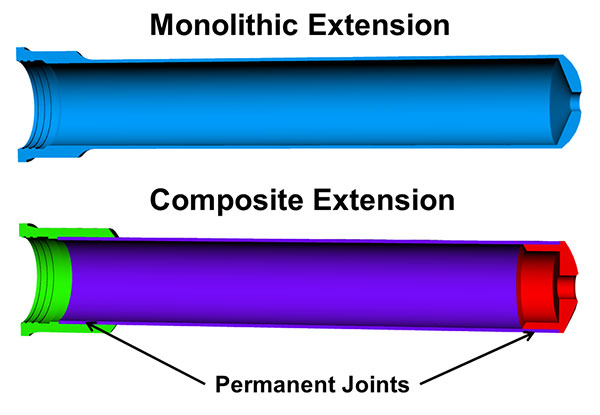
Cmparison of monolithic & composite single-piece extensions
Of course, the benefits of monolithic extensions are often over-stated. For one thing, no matter how durable an extension is, there’ll still be a weakness where the extension threads onto the magazine tube. This is far more likely to become a failure point during rough handling than a brazed-on end cap or coupling, especially for single-piece extensions, which are often not installed with reinforcing clamps. I’ve also heard it claimed that the Vang Comp’s monolithic construction makes it more dent-resistant than others, but since its extended tube section has the same wall thickness as other 12ga extensions with standard inner and outer diameters, the structural limits of the tube will obviously be very much the same (in fact, brazed-on end caps like the one shown in the above image can actually help to further reinforce a small portion of the tube).
Monolithic construction is a nice feature, especially if it’s taken advantage of to refine other attributes like weight or capacity. However, it’s certainly not a guarantee of superiority, nor does it result in an extension that “simply has no weaknesses”, as Vang Comp’s website claims.
The overall length of the Vang Comp +2 is slightly under 6 1/8”, meaning it will end at about the 17 7/8” mark along the barrel when installed on a standard 870 with a 4-round base magazine tube (standard 870 barrels should have 11.75” between the breechface and the front of the barrel guide ring). I generally prefer to see extensions take full advantage of the space under the barrels that they’re intended to match, but this will likely be a positive feature for those who dislike the look of a magazine that’s longer then the barrel. With its slightly undersized length, this extension is pretty much guaranteed not to stick out past the muzzle of a defensive barrel, even if the barrel is a minimal 18” long, and even if an under-cap accessory (which should be less than 1/8” thick) is installed beneath it.
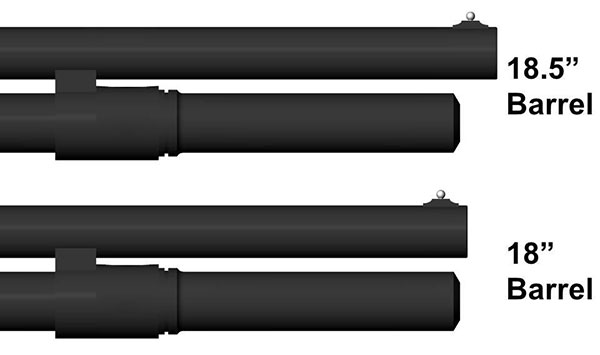
Vang Comp +2 extension installed on standard mag tubes with 18.5” & 18” barrels
The H&R Pardner Pump 870 clones with 5-round magazine tubes have barrel guide rings a hair over 15 inches from the breechface, and the newer 870 Express Tacticals with 6-round base magazine tubes have barrel guide rings located 16.5” from the breechface. If installed on one of these non-standard 870s, the Vang Comp +2 will end 21 1/8” and 22 5/8” from the breechface, respectively. All current-production long-mag Express Tacticals have 18.5” barrels (not including extended choke tubes), so the Vang Comp +2 would extend 4 1/8” past the muzzle on one of these. If installed on an 18.5” Pardner Pump Protector, the Vang Comp +2 would extend 2 5/8” past the muzzle. Neither arrangement should cause any functional problems, aside from the extension tube requiring a little extra cleaning after shooting.
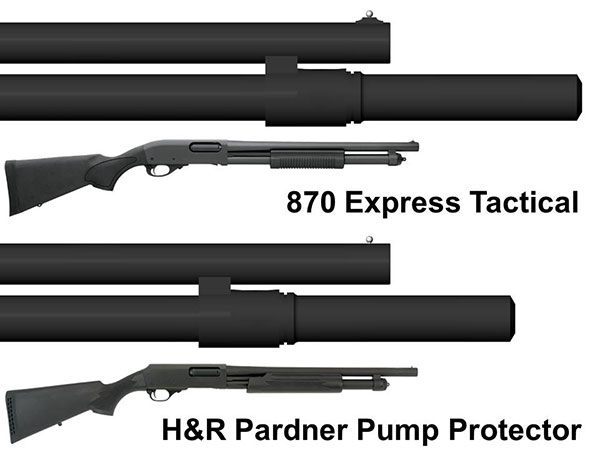
Vang Comp +2 extension installed on non-standard mag tubes with 18.5” barrels
The base of the extension is about 1.25” in diameter, and features diamond-pattern knurling for added grip. This knurling is less than impressive, however. It’s rather shallow and flat, more a set of criss-crossing lines than a pattern of raised points. It adds a little texture, but doesn’t provide nearly as much traction as full knurling would have. I have to use both hands on the extended tube section to get enough grip to properly tighten the extension. You may find yourself having to use pliers if you have a wave washer or an under-cap accessory with a detent ball underneath it.
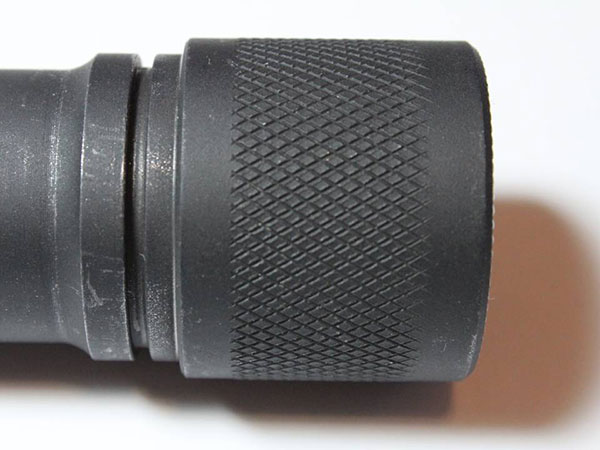
Detail of the Vang Comp +2’s knurling
The base of the extension has ridges cut into the bottom that are meant to engage the magazine cap detents on barrels that feature them. These ridges are fairly narrow and shallow, and while they do engage magazine cap detents, the base of the extension is barely wide enough to reach the detents (the detents on my barrels, at least), especially since the base of the extension is chamfered, keeping the ridges from extending out to the base’s full diameter. When the extension is installed, about half of the detent is still visible, and wear marks show that only the very outside ends of the ridges are engaging it.
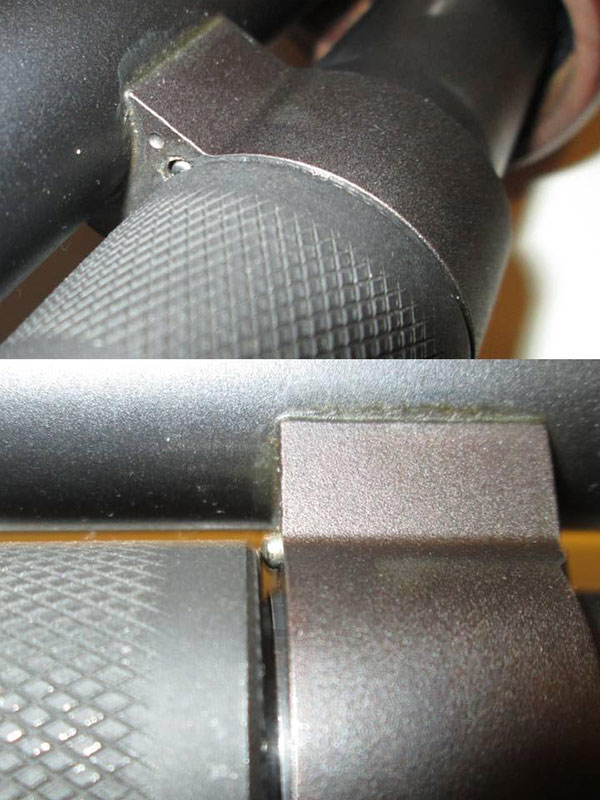
Magazine cap detent just barely engaging the extension’s base
As a result, the Vang Comp extension is noticeably easier to turn against the detent than other extensions or magazine caps with deeper, wider notches or dimples; and the relatively delicate ridges seem far more prone to wear with repeated installation & removal. This goes especially for the hard detent balls used in some under-cap sling plates; hand-tightening the Vang Comp +2 onto a GG&G sling plate with a detent ball only once left a deep gouge completely through the ridges.
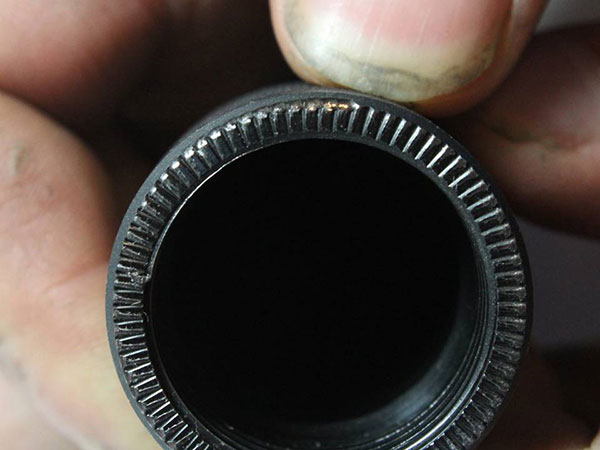
Detail of the detent engagement ridges, showing damage from sling plate detent ball
I can appreciate the weight savings of a slim extension base, and there’s some aesthetic appeal to having the extension match the outer diameter of the barrel guide ring, but I don’t consider those benefits to be worth such tenuous detent engagement. If Vang Comp really felt they needed to keep to this 1.25” maximum outer diameter – perhaps to avoid interference with very heavy-walled barrels – they should have put more effort into achieving a positive engagement with magazine cap detents. It could be that these ridges are faster or cheaper to machine than factory-style dimples or slots, or maybe Vang Comp just wanted to do something different.
About 1.5” up from the base, the extended tube section has a standard 1” outer diameter that should be compatible with a wide variety of clamp-on accessories. The forward end of the tube features a wide, shallow chamfer and a flat front face. Many magazine extensions have a central vent hole here, but the Vang Comp extensions have a solid end with no hole. Some may prefer this solid tube end, as it ensures that foreign material cannot enter the magazine tube if the gun is dropped muzzle-first into mud, water, or snow. It also gives the front of the extension a nice, clean appearance, at least to my eye.
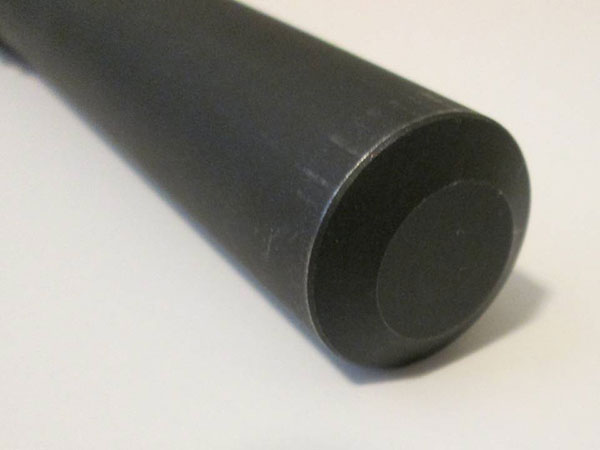
Front end of Vang Comp +2
On the other hand, the lack of a vent hole means that if any water does make its way into the magazine, it will not be able to easily drain out (remember, whether its muzzle end is sealed or not, an 870’s magazine is always open at the other end). A vent hole also reduces mass slightly, helps to limit pressure drag, and allows a dowel or rod to be inserted to control and align the magazine spring during assembly and disassembly. So there are certainly trade-offs to sealing the end of a magazine tube. Personally, I’d rather have a vent hole, but I’ll admit it’s a fairly minor nit-pick, and one that could be addressed in minutes on a lathe.
Moving inside, the interior of the extension is fairly rough, almost as if the machinist forgot to make a final finish pass during the boring process. This had a noticeable effect during loading, I could clearly feel and hear when the metal follower & shell rims reached the extended tube and started scraping along the uneven surface. Considering Vang Comp’s good reputation and the price of this extension kit, I was quite surprised to see such sub-par machining.
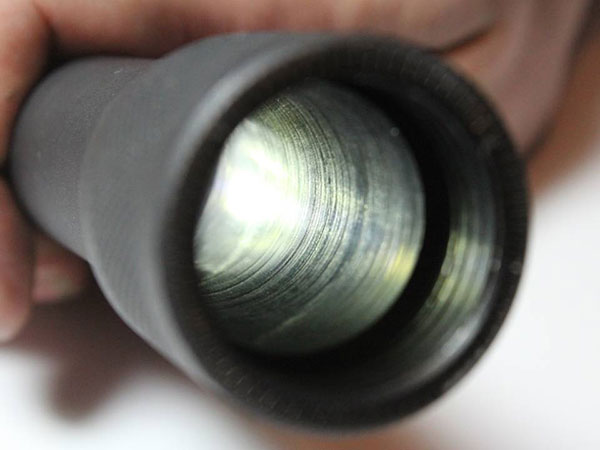
Rough surface inside the Vang Comp extension
In addition, the female threaded area in the extension’s base can accommodate up to 15/32” (.46875”) of the threaded end of a magazine tube. This is excessive to say the least, as 870s typically only have about .3” of exposed magazine tube thread with the barrel in place. Some guns will have a hundredth of an inch or two more than that, but I’ve also measured guns with as little as .23” of magazine tube ahead of the barrel guide ring, and adding sling plates or other under-cap accessories can reduce the amount of tube exposed by another tenth of an inch or so.
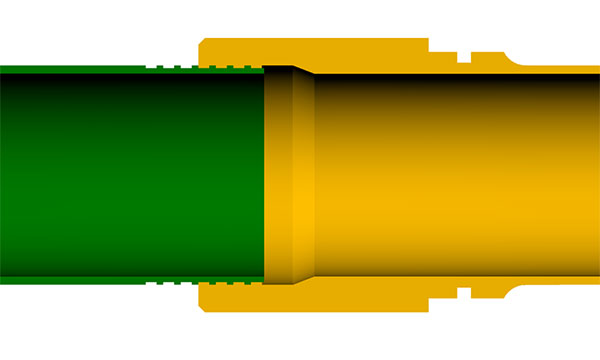
Illustration of the remaining gap between the base magazine tube and the extension’s tube section with the magazine tube threaded a typical .3” into the extension
With over half an inch of space before the interior of the extension shrinks down to the standard mag tube inner diameter, there will be a substantial gap between the two tube sections with pretty much any 870. Between this wide gap and the abrupt transition from the threaded area to the narrower extended tube, very careful follower selection will be needed for the Vang Comp +2 to run reliably.
Follower:
On that subject, Vang Comp’s magazine extension kits come with the company’s own replacement stainless steel magazine follower. This follower is also sold separately on Vang Comp’s website for $22.
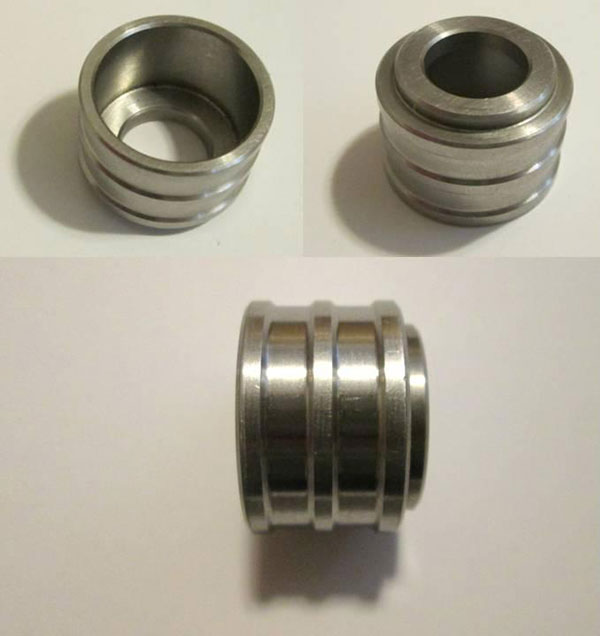
Vang Comp’s stainless steel 12ga follower
This is a cup-style follower with a body that’s .9” in diameter and .63” long, and an internal cup that’s .75” wide and half an inch deep. The body is broken up by two wide grooves that leave three raised bands for the follower to slide on. Running through the center of the follower is a .47”-diameter hole that saves a little weight, and should help to relieve pressure drag in the sealed Vang Comp extension. But the main purpose of this hole, according to the follower’s page on Vang Comp’s website, is to make it easier to feel when the magazine is empty. This it does very well; the hole is immediately and positively apparent to the touch, and clearly distinguishes the follower from the base of a shotshell.
Unfortunately, the same cannot be said for visual checks of the magazine. The bare stainless steel could very easily be mistaken for a steel shell cup or vice versa, especially for rushed and/or distracted users. Painting the visible end a bright color is a recommended safety step for anyone using this follower; though for such an expensive – and supposedly top-end – aftermarket part, this really should have already been done by the manufacturer.
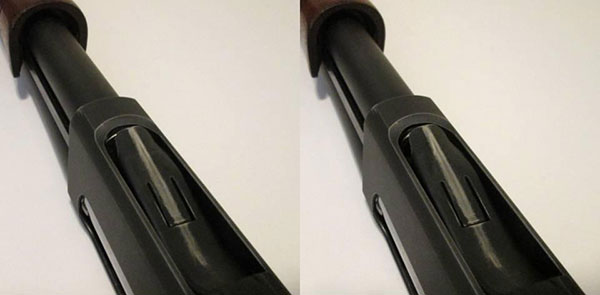
Can you tell which one is loaded and which is empty in a second or less?
I’ll state right here that I am not a fan of metal magazine followers. I’m fully aware that the 870 and many other shotguns have used metal followers in decades past. However, today’s modern polymers are more than strong enough to handle the minimal stresses experienced by a magazine follower, and compared to steel alternatives, quality polymer followers are lighter, less expensive, inherently high-visibility (as opposed to paint or other surface treatments that can wear off), lower-friction, immune to corrosion, far easier to modify if needed, and cause less wear to other parts in the gun that are not as easy to replace. The only real downside to polymer followers is their shorter operating life, but with good design and material selection, appropriate replacement intervals should still be measured in years, if not decades. As with virtually any firearm, the 870 has a number of components that should be replaced periodically to ensure reliable function, so also replacing the follower occasionally is not that big of a deal. I personally have no problem with buying and installing a new polymer follower every once in a while in order to get all the other advantages of the material – especially since even high-end polymer followers are not all that expensive.
But with that said, I’m going to set the issue of material aside because this follower’s biggest problems are a result of its triple-bearing-band geometry, not what it’s made from. This same design in aluminum or polymer would have the same functional problems.
Vang Comp’s website claims that the follower’s reduced bearing surface makes it travel smoother in the magazine tube, which doesn’t make much sense. Sliding friction is dependent on two things: the coefficient of friction between the two surfaces in question, and the magnitude of the force pressing those surfaces against each other. Reducing the contact surface area will not directly affect the total friction between non-deforming surfaces.
It’s also claimed that the grooves between the rings will collect debris that ends up in the magazine tube, making the magazine easier to clean. I can’t really refute or confirm this, but either way, I don’t think it’s much of a consideration. In my experience, the 870’s magazine isn’t that prone to collecting powder residue to begin with. The only route by which smoke or soot can get from the chamber & receiver into the magazine is pretty well blocked by a shell or the follower. My live-fire testing of the Vang Comp extension included one long range session where I ran hundreds of shells – mostly inexpensive target loads & cheap buckshot with fairly dirty powders – out of an 870 that had already gone months without a cleaning. By the end of the day, the inside of the receiver was pretty well gummed up, and there was noticeable added resistance when cycling the action, but when I pulled the gun apart for cleaning that evening, the interior of the magazine tube just needed a quick wipe, and the stainless follower was virtually spotless.
One thing I can say about this bearing-band design is that it significantly reduces reliability with magazine extensions that have any kind of internal gap. A couple fundamental aspects of magazine followers are at play here. In order to move freely, any magazine follower must be slightly smaller in diameter than the interior of the magazine tube, and this difference in diameter allows the follower to tilt slightly inside the tube. The greater the diameter difference, the more extreme the follower’s maximum tilt. The extent to which the follower is able to tilt also depends on the follower’s length; the longer the follower, the less it can tilt before its opposite edges make contact with the wall of the magazine tube.
In a seamless tube, a triple-bearing-band follower would theoretically have the same maximum tilt as a constant-diameter follower with the same outer diameter and effective body length, since the very front and rear edges of the body are going to be the only points of contact in both cases. But if one of the outer bands on a triple-bearing-band follower becomes unsupported – as it would in the gap between a magazine tube and a single-piece extension – the constraint on follower tilt shifts immediately to the outer edge of the central bearing band, effectively making the follower’s body much shorter. This trait allows the Vang Comp and other similar followers to tilt much further than a constant-diameter follower would in the same situation, getting the leading edge of its body deeper into the gap between the two sections of the magazine.
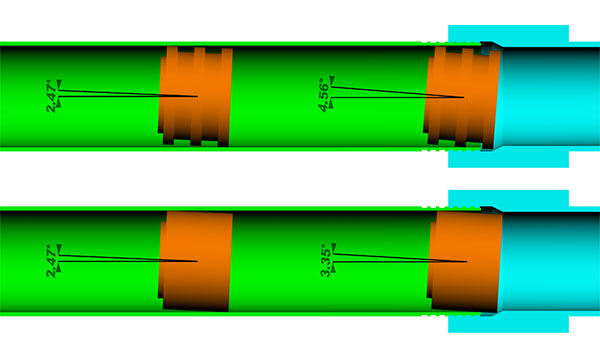
Example of possible tilt for constant-diameter & triple-bearing-band followers with the same maximum diameter & effective body length (dimensions not representative of any actual followers), showing how bearing-band followers are able to tilt significantly more with an unsupported outer band
In addition, the Vang Comp follower has fairly abrupt leading and trailing edges, with only a very slight chamfer to break the corners. This makes it prone to hanging up at the joints of two-piece extensions as well as those of single-piece designs. To be frank, I would only recommend using this follower in single-piece, non-extended magazine tubes (more specifically, single-piece magazine tubes without spring retainer dimples, as the Vang Comp follower is not slotted). It might also be usable in a +1 extension if it’s paired with a spring that’s long enough to keep the follower inside the base magazine tube. For +2 or longer extensions though, especially single-piece designs with gaps at the transition, this is not the most reliable follower design.
What makes this worse is that the official description of the Vang Comp +2 extension kit lists the included follower as a $22 value. If almost 30% of the kit’s cost is going toward something that should just be replaced, that’s an issue.
Spring:
The Vang Comp +2 extension kits include a new, “extra-power” (their words, not mine) magazine spring. This spring’s design is fairly unremarkable; it’s a simple straight spring with a constant .726” outer coil diameter, squared ends, a solid length of .58”, and a solid length ratio of about 33.
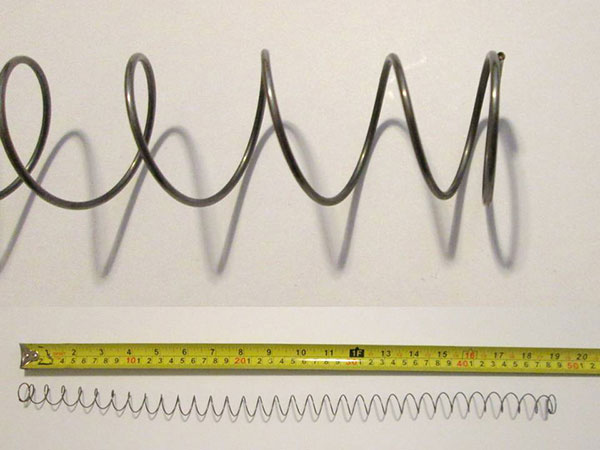
Vang Comp extension spring
What is noteworthy is that this spring is only about 19” long when relaxed (this is after its initial break-in, it measured at 19.5” out of the box), less than two inches longer than the total interior magazine space. When tested with the Vang Comp +2, the spring exerted a very low empty force – so low that I couldn’t get an accurate reading from the scale I normally use to test spring force. Best as I could figure using a digital postal scale (which is not the best instrument for this type of measurement), the empty spring force in new condition was around 10 ounces (0.625 pounds), and only 8 ounces (half a pound) after break-in.
That’s less force than I get with a magazine cap and my factory 4-round magazine spring (the standard 4-round spring, not the longer police 4-round spring). I’ve owned and used my 4-round spring for years, and even cut a couple coils off of one end, but it’ll still give me about 1.25 lbf (or 20 ounces) at empty without a magazine spring retainer. If my used, shortened factory magazine spring is twice as strong as the Vang Comp spring in out-of-the-box condition, Vang Comp has no business marketing it as an “extra-power” spring.
During quick cycling, extremely weak magazine springs can obviously lead to feed malfunctions if the shell isn’t pushed all the way out of the magazine before the carrier starts trying to lift it. This will jam the gun and prevent the bolt from going into battery until the slide is brought to the rear again. Another issue with a weak magazine spring can arise when the gun is cycled under recoil. When a tube-fed shotgun recoils rear-ward, the shells in the magazine will tend to shift forward relative to the rest of the gun due to inertia. If the magazine spring is not strong enough to limit this reaction and get the shells back against the rear-most shell latch in time, the next shell may never leave the magazine and the bolt will close on an empty chamber. This malfunction is more likely to occur in extended magazines, as having more shells in the tube increases the amount of inertia that the magazine spring must work against. Either of these problems could be deadly in a defensive shooting, which is why it is imperative that extensions marketed for combat use include a robust spring.
On its own, this doesn’t seem like a bad spring. With its short solid length and ability to fit into cup-style followers, I could see it working well for maximizing capacity in a +1 extension on a hunting shotgun. Perhaps Vang Comp wanted to use one spring in both their +1 and +2 extensions, but if that’s the case, instead of using an intermediate-length spring in both kits, it would have been far better to size the spring for the longer +2 extensions, and let those who buy the +1 kits trim it if they find it to be too long and stiff for their needs. In a +2, this spring is extremely underpowered, and should probably be replaced (adding another $5 – $10 to the cost of this kit). I would not trust it to feed shells reliably in anything but the most laid-back shooting – and I’d even be less than confident there, given how fast the spring lost stiffness during my testing (more on that later).
Using this spring with the Vang Comp +2 on a 5-round 870 clone or a 6-round Express Tactical is hardly worth talking about. If the Vang Comp +2 is installed on either of these long-mag variants, the total magazine tube space will be greater than the spring’s relaxed length.
Capacity:
The Vang Comp +2 extension has about 5 15/32” (5.46875”) of internal tube space as measured from its base to the internal end of the tube. I arrived at this figure by inserting, marking, and measuring a flat-ended 7/8” wooden dowel, but I’ll note that the forward end of the tube is conical rather than flat, due to how these extensions are machined. This means that the effective internal space of the extension may differ by a fraction of an inch depending on the specific spring and/or follower you’re using. And of course, as with any single-piece magazine extension, the magazine’s total internal space is directly influenced by how far the extension is threaded onto the end of the magazine tube. I’ve found .3” of exposed magazine tube thread to be about typical for 870s, but this number can vary, especially with 870 clones, or if under-cap accessories are used. If you want to know exactly how much space you’ll have to work with, you should measure your own shotgun and do the math to adjust the following numbers as necessary.
That said, with a typical amount of thread engagement, installing the Vang Comp +2 on a standard 4-round magazine tube results in a total internal tube length of right around 17.3” from the forward shell latch to the internal end of the extension. At full compression, the spring and follower included in the kit reduce this available space to right around 16.08”. With 5- and 6-round magazine tubes, the total internal space should be roughly 20.6” and 22”, respectively. The amount of that space available for shells depends on the specific spring being used, since the included spring will not function in these longer magazine tubes.

Maximum crimped shell length for various capacities
When the Vang Comp +2 is paired with a standard 4-round magazine tube, there is easily enough space for six SAAMI-compliant 2.75” shells, which would conform to a maximum crimped length of 2.45 inches. It’s not quite enough space to ensure the same capacity with longer-crimped 3” shells (SAAMI specifies a 2.76” maximum crimped length for them, and magnum 870s can even feed slightly longer shells), but most 3” magnums will be short enough that you won’t see a loss in capacity. This extension should also be a +2 with 3.5” shells (which have a SAAMI-specified 3.155” maximum crimped length) if installed on an 870 SuperMag, increasing capacity from 3 shells to 5 shells. The Vang Comp +2 can even act as a +3 with many shorter-crimped 2.75” or 2.5” shells. During my range testing, I could load seven Federal bulk-pack target shells into the magazine without excessive difficulty when using the included spring & follower.
However, if you replace these parts with a more reliable spring & follower set, such as those from Wilson Combat (about $12), S&J Hardware ($20), or Remington ($10 for both, though probably half that since most 870 owners will already have a factory follower), capacity will be reduced somewhat because the spring will be longer and the follower may have a thicker body. This will likely prevent loading seven in the magazine with typical 2.75” shells, and also more meaningfully affects capacity with 3” shells. I have some roll-crimped 3” Sellier & Bellot 15-pellet magnum 00 buckshot shells that are crimped to around 2.65 inches long, and with a Wilson Combat follower & +2 spring in the Vang Comp extension, I can only barely fit the sixth shell past the first shell latch (which would technically allow the magazine to hold & feed the shells, but prevents certain shooting techniques and greatly increases the likelihood of slip-ups or jams during rapid loading). With a Remington extension spring and follower, there isn’t even enough room for six quite typical fold-crimped Remington 3” magnum buckshot shells (about 2.52” crimped).
Now, it’s not all that unusual for 3” magnums to be a tight fit in +2 magazine extensions, but if we stop to think about that fact, it seems a bit odd. Six 3” shells with typical fold crimps only take up around 15.5 inches when placed end-to-end, and rarely more than 16” even with shallow roll crimps. So why is it that we can’t get this much space out of magazines that are 18 -18.5 inches long externally?
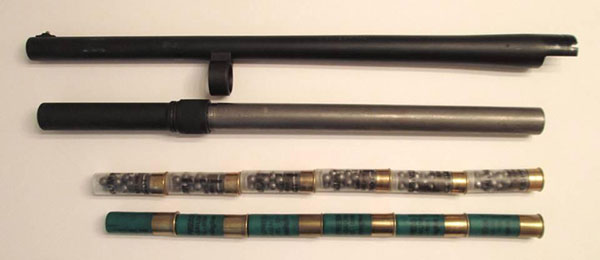
Those sure look like they should be able to fit in there…
Well, in the case of the Vang Comp +2, it’s because the extension’s interior is what I can only describe as incomplete. Remember that the Vang Comp extensions are machined from a single piece of bar stock, and part of that machining process is boring out the inside of the bar to form the extended tube. For whatever reason, this boring process was stopped well before the end of the extension, with about half an inch (depending on where you measure from) of solid metal remaining between the internal and external ends.

Cross-section showing thick front end of the Vang Comp +2
This is similar to an issue with the Wilson Combat +2 extension that I called out in a previous review. However, that extension is not machined as one piece; it has a separate end cap that is permanently attached to the extended tube section. Because the Wilson Combat extensions are relatively low-cost kits, I can recognize a benefit to an end cap with fewer machining steps. The Vang Comp +2, on the other hand, is a monolithic design, so I cannot think of any valid reason for only partially boring out its interior. The machining step is already there, so why not take it three-eighths or half an inch deeper and have a lighter, more capacious extension? To those who claim this thick end improves durability, half an inch of solid steel on the end of the extension does nothing to reinforce the much thinner tube walls just behind it, or the shallow threads that attach the extension to the gun.
I will step back and recognize that even with a longer spring & solid follower, the Vang Comp +2 can be counted on to live up to its rated capacity with the 2.75” shells that are best suited for use in fighting shotguns. Since this extension is designed and marketed for tactical applications, that’s the significant criteria it needs to meet. The limitations with longer 3” shells are not unique to Vang Comp extensions, but in the context of this extension’s price tag and construction, I can’t help but hold this less-than-optimized capacity against it.
Sling Attachment Hardware:
The Vang Comp +2 extension incorporates a side-loop sling plate that allows for the direct attachment of slings up to 1 1/4” wide. This plate is able to rotate freely about the extension so as not to interfere with installation or removal, and is held in place just forward of the extension’s base by an external retaining ring. Because this retaining ring is relatively easy to take off with simple retaining ring or needle-nose pliers, the sling plate can be reversed or removed depending on the needs and preferences of the user. When the extension is installed on the gun, the plate is held in its intended orientation by a radiused cut-out that engages the barrel.
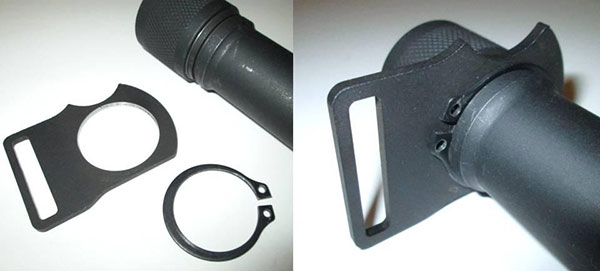
Vang Comp extension sling plate
The concept here is essentially the same as under-cap side-loop sling plates, which center on the magazine tube and index on the barrel the same way. But instead of sitting between the barrel guide ring and the magazine cap or extension, this plate is mounted farther forward on the extension itself, with the front face just short of 1.2 inches ahead of the barrel guide ring. This keeps the sling plate from complicating take-down & reassembly or reducing thread engagement (weakening the joint and potentially contributing to function problems) like under-cap sling plates. This basic concept of extension-mounted sling plates is a solid one. Unfortunately, there are a number of issues with this particular execution of that idea.
A big disadvantage with the Vang Comp sling plate is its poor barrel fit. There are a wide variety of barrels made for 12ga 870s, with differing outer diameters and center-to-center spacing between the barrel and mag tube, and there’s simply no way to manufacture a plate that is a perfect fit to every 870 barrel right out of the box. Sling plates from most manufacturers are generally designed to fit standard-profile barrels. While this can lead to some play with certain light-profile or high-spaced barrels, or require modifications to be used with heavy-profile barrels, the fit will be good and tight with the majority of hunting/sporting 870s as well as nearly all defensive/combat models, so it’s a good compromise.
The Vang Comp sling plate, on the other hand, is very loose-fitting. The idea seems to be that it can be paired with any 870 barrel, even heavy-profile ones, without requiring any modifications. The consequence is that with the majority of 870 barrels, this sling plate will have a severe amount of free play, rattling in place and potentially marring the barrel’s finish over time.
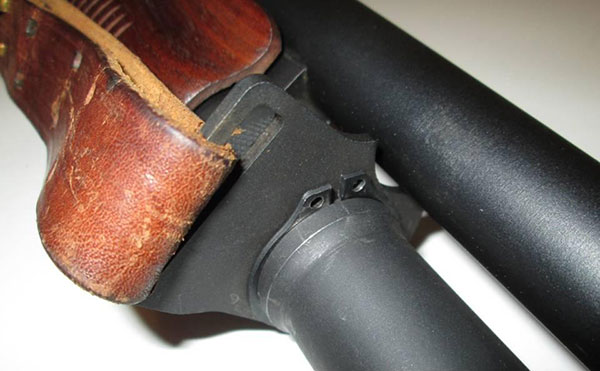
Mismatch between Vang Comp sling plate & standard-profile barrel
While I can imagine a reason for this design, I don’t think the decision was thought through very well. The only barrels I’m aware of that this sling plate might actually fit are either fully-rifled slug barrels, or high-dollar custom barrels intended for “outlaw” turkey/card-shooting events. Even if someone did want to run an extended magazine for these applications, they probably wouldn’t have a need for a tactical/competition-style side sling loop. I feel it would have been much wiser for Vang Comp to equip their extensions with a sling plate that was a better fit with the more common barrel profiles used by Police & Express 870s, and perhaps offer this heavy-barrel-profile sling plate for purchase separately if they felt there was actually a market for it.
Another downside to these plates is that the sling loop can only be oriented to the left or right. Other manufacturers such as S&J Hardware and Wilson Combat market extensions with similar sling plates, but theirs can either be oriented both vertically and to the sides, or are available in different versions with those orientations. With the Vang Comp sling plate, you’re limited to the sides only. The problem with this is that nearly all factory 870 stocks – and many aftermarket ones – only come with bottom-mounted sling attachment points. While it is possible to run a sling from the bottom of the stock to the side of the extension, it makes for a rather awkward setup. To properly match the sling loop on the Vang Comp +2, most users will either have to add a side sling attachment point to the other end of their shotgun, or add a separate vertical sling attachment point to the front of the gun (replacing the Vang Comp sling plate).
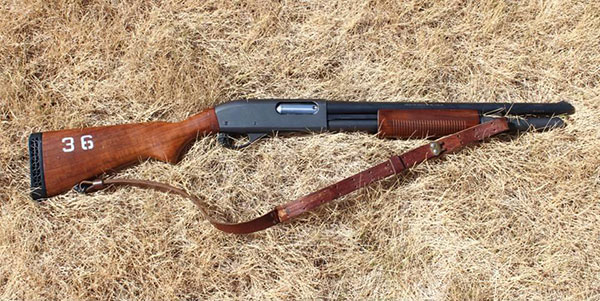
Sling mount orientation mismatch with a factory 870 Police stock
Also, the sling loops, while simple, are not conducive to quickly attaching & detaching slings. Each time a sling is installed on or removed from the sling loop, it will have to be partially taken apart; it cannot be unhooked the way carry slings with quick-detach hardware can be. While some folks do prefer to leave a sling on their fighting or competition shotguns at all times, there are many other situations where an easily-removable sling is an advantage. A sling is often considered a liability on a home defense shotgun that is intended to be used indoors, for example, but it’s nice to be able to quickly throw one on to investigate suspicious activity or deal with animal threats outdoors. Hunters chiefly use slings only while traveling to and from their hunting area. Once there the sling is of little use, and fumbling with straps and buckles – especially while wearing gloves in cold weather – is an unwelcome and unnecessary added headache.
What makes these issues worse is that avoiding or fixing them would have been as simple as adding another barrel cut-out to these sling plates so that they could be oriented vertically as well as to the side, and manufacturing and offering alternate sling plates with different attachment styles. A sling plate with a vertically-oriented stud for standard quick-detach sling swivels is a sorely-needed option, and a multiple-orientation plate that could accept push-button sling swivels would be welcome as well.
I am aware of one pair of alternate sling plates for Vang Comp extensions offered by Mesa Tactical. These plates feature round loops for clip- or hook-type quick-detach sling hardware. The standard sling plate has one hook loop, and barrel cut-outs for orienting that loop to either the right, left, or bottom of the extension. The ambi sling plate version has a pair of hook loops that sit to the left and right of the extension when installed. I can’t speak for how well these aftermarket plates function, but in the images on Mesa Tactical’s website, the barrel fit of these aftermarket plates also appears to be quite loose.
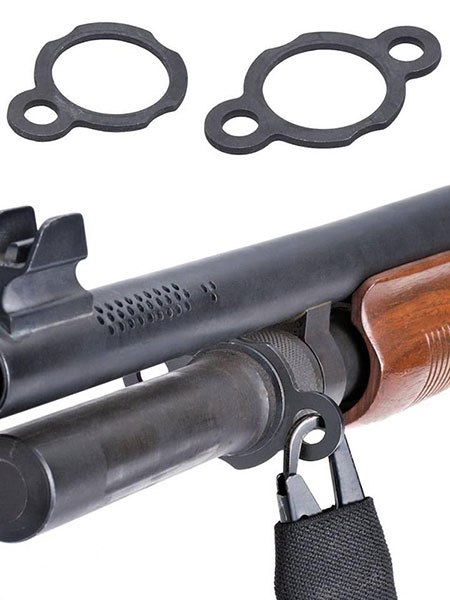
Mesa Tactical hook-loop sling plates for Vang Comp extensions
There is always the option of custom sling plates, which to Vang Comp’s credit are fairly straightforward to design and manufacture for these extensions. Aside from the barrel cut-out, which will obviously depend on your specific barrel, the critical dimensions for custom sling plates are a .1” thickness and a 1 1/8”- diameter center hole. If you don’t want to make your custom sling plate from scratch, under-cap sling plates from other manufacturers could likely be adapted and installed on Vang Comp extensions as well, since the plates would still be centered on the axis of the magazine tube. As long as the plate is .1” thick (plates thinner than .1” could also potentially be adapted with the use of shims), all you’d need to do to would be to open up its center hole to 1 1/8”. Unfortunately, many 870 owners will not have the skills and/or equipment to make custom sling plates without the (usually paid) assistance of someone else.
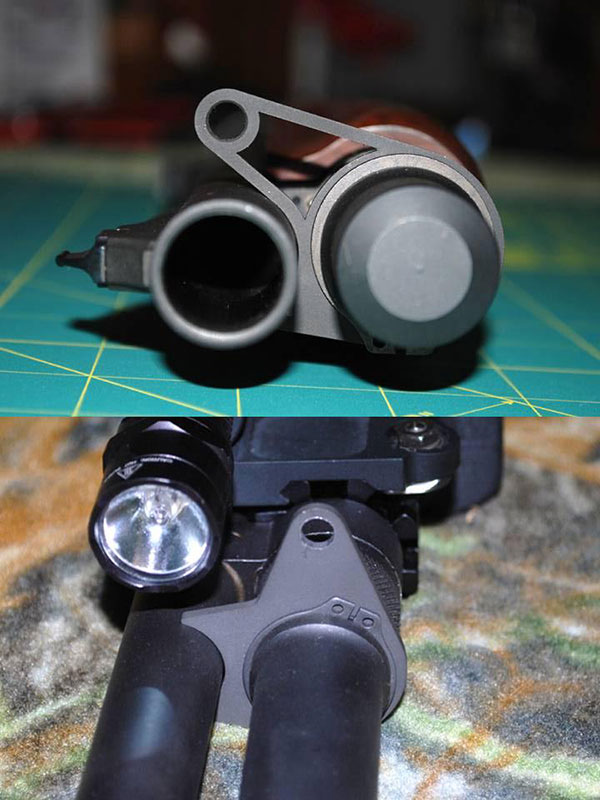
Custom sling plates made for Vang Comp extensions by forum user Banshee
In a nutshell, the sling plates on this extension are rather lacking. Barrel fit, sling attachment options, and compatibility with factory rear sling attachment points are all misses on Vang Comp’s part. Most 870 owners who buy the Vang Comp +2 should expect to have to purchase and install additional accessories if they want to be able to properly mount a sling on their shotgun. The only well-done element here is the method of attachment, which allows for easy removal & replacement of the stock sling plate or straightforward design of custom sling plates. However, this feature is not unique to Vang Comp extensions.
Finish:
The Vang Comp +2 has a matte black finish that matches Remington’s current factory Parkerizing and Express matte black oxide finishes quite well, though it appears most similar to the deeper, less reflective Parkerizing. Based on this, along with the extension’s price and some misinformed claims I came across online, I operated under the assumption that this extension was Parkerized (a metal-phosphate conversion coating) during my initial evaluation. But after reading up on it for this review and observing how it stood up with use, I eventually figured out that it was actually a black oxide finish.
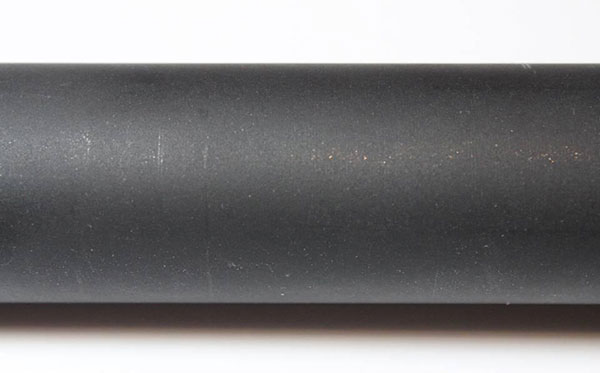
Close-up of black oxide finish on Vang Comp extension
Black oxide finishes are the result of a passivation process that forms a thin layer of magnetite (black iron oxide, or Fe3O4) on the surface of steel alloys. When treated with an after-finish (usually an oil for firearm parts, with waxes and lacquers preferred in some other applications), this oxide layer does reasonably well at protecting the underlying steel. However, it tends not to be as effective or durable as phosphating/Parkerizing, which is thicker, tougher, and not completely reliant on oil or some other after-finish for corrosion protection (though it is enhanced by them). This is the reason Parkerizing is a preferred finish for steel gun parts in military applications.
While highly-polished black oxide finishes (AKA traditional gun bluing) can be preferred over phosphating for aesthetic reasons, matte black oxide finishes are frequently used in the firearm industry as a lower-cost alternative meant to mimic the appearance of phosphating. With cost-effectiveness usually prioritized over performance, these oxide finishes tend to be rather thin and easy to wear off.
The finish on the Vang Comp +2 is a prime example of this type of oxide finish. Though it hasn’t seen all that much actual shooting, my extension is already festooned with scratches and wear spots that show bare metal, just as a result of me handling it, installing & removing it on my 870 multiple times, and removing & replacing its sling plate. This is, frankly, a very light-duty finish; rather disappointing considering that even some $40 – $50 extensions can be had with Parkerized finishes. With this extension kit’s higher price tag, and the fact that it’s clearly designed (or at least marketed) for combat applications, I’d expected it to have a finish that could better hold up to heavy use or harsh conditions.
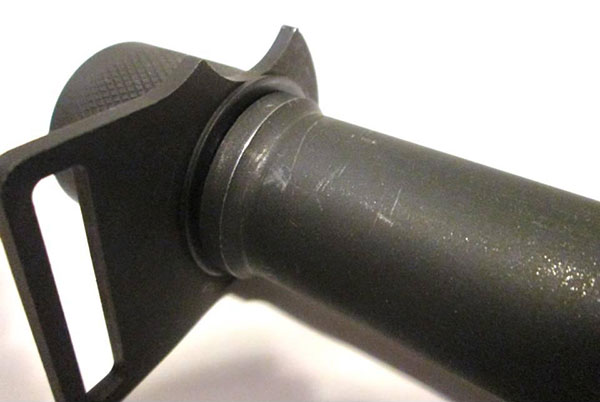
Finish wear on Vang Comp extension
For a home defense shotgun that’s well cared-for and primarily kept indoors, this light-duty finish isn’t really an issue. Oil it just like you would Parkerizing, and it should be fine. But if you’re building a combat or sporting gun that will see a lot of rough use, it probably wouldn’t be a bad idea to hand this extension off to a gunsmith for stripping and refinishing – or to do it yourself if you have the proper equipment and chemicals. Thanks to the monolithic construction of the Vang Comp extensions, refinishing should be fairly simple and straightforward, though once again, it’ll add to the kit’s cost.
Weight:
The Vang Comp +2 extension, spring, follower, and sling plate with retaining ring have a combined total weight of about 8.9 ounces. A typical 870 magazine cap (with sling stud), 4-round spring, metal spring retainer, and factory polymer follower weigh about 2.2 ounces total, while the equivalent parts for a new-style internal-ratchet 870 total at about 1.75 ounces (without a sling stud); so expect this extension to increase an 870’s unloaded weight by something in the neighborhood of 6.7 – 7.15 ounces, depending on the specific parts you’re replacing. That’s assuming you use everything that comes in the box, however. Together, the sling plate and stainless steel follower account for about 1.5 ounces of the kit’s total weight. With the rattle-prone sling plate removed, and a lighter polymer follower swapped in, the total installed weight of the kit can be reduced to around 8 ounces even (give or take an ounce or so, depending on which follower & spring you go with).

Weight break-down for the Vang Comp +2 kit
The extension tube by itself weighs 7 ounces, which is not too flattering even for a steel extension. The solid nose is an obvious contributor to this. By my math, fully boring out the interior as discussed earlier could have made the extension at least an ounce lighter, with no meaningful structural or performance disadvantages. Even if there was some valid technical reason that Vang Comp couldn’t get a drill bit or boring bar any deeper into the part, they could have just used a shorter piece of bar stock to begin with, reducing weight & inertia for the shooter, and materials costs for themselves.
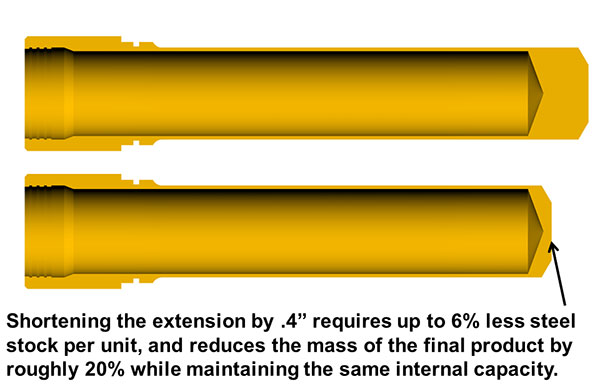
Shorter, lighter Vang Comp +2 with the same internal geometry
Now, I can step back and recognize that the Vang Comp extension kit is not unusually heavy compared to competing kits from other manufacturers, and that shaving off an extra ounce or so won’t have a major effect on an 870’s handling – most users probably wouldn’t even notice it, honestly. But if I can take a hacksaw and cut more than 3/8” of dead weight off the end of an extension without any negative functional effects, and there’s no conceivable economic or logistical justification for it being there, I have to call that extension out as a flawed design.
Installation:
Ensure that the gun is completely unloaded, then unscrew the magazine cap (or extension), magazine spring, and follower (if you plan on replacing your current follower). Remove the magazine spring retainer and magazine plug, if present. If the gun has dimples in the forward end of the magazine tube, these will have to be drilled or pressed out for the extension to have its full capacity.
If you will be using the sling plate, make sure it is able to rotate freely in place. If you want to remove or reverse it, use a pair of snap-ring or needle-nose pliers to spread and remove the retaining ring, then slide the sling plate off. To replace the sling plate, slide it over the extension in the desired orientation, and use your pliers to replace the retaining ring. Make sure that the retaining ring is completely seated in its groove before proceeding.
To install the extension on the gun, ensure that the barrel is properly seated in the receiver, and insert the magazine follower and extension spring you wish to use into the magazine tube. Place the extension over the end of the spring, make sure the sling plate (if you are using it) is properly aligned with the barrel, then thread the extension onto the magazine tube and tighten it down firmly against the barrel guide ring.

Installation of the Vang Comp +2
If you cannot get a good enough grip to properly hand-tighten the extension, use a strap wrench or a pair of channel-lock pliers (preferably with a piece of leather placed in the jaws to avoid damage) on the base of the extension to snug it down. When using tools to tighten a magazine cap or extension, be very careful to avoid over-tightening, as doing so can strip the magazine tube threads or bend the barrel’s guide ring out of alignment.
Function, Reliability, & Common Problems:
The function of any magazine extension revolves around its ability to reliably accept and feed shells. I subjected the Vang Comp +2 kit to my usual acid test of threading the extension onto a spare magazine tube with various amounts of thread engagement, inserting the spring and follower, and working the follower back and forth across the internal transition using a 7/8” wooden dowel with one end cut about ten degrees from square. The angled end of the dowel serves to cant the follower inside the magazine, giving the best possible chance for it to snag at the internal gap between the magazine tube and the extension so that I can examine how the system behaves when a worst-case hang-up occurs.
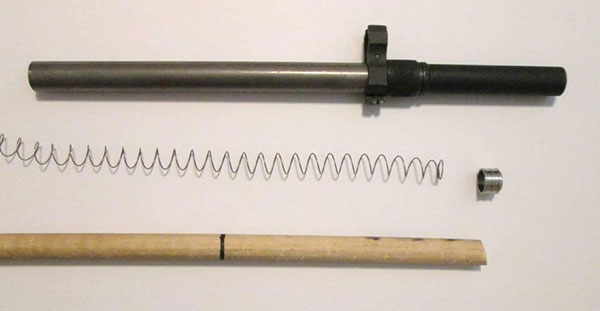
Dowel test setup
The results were not encouraging. When canted by the dowel, the Vang Comp follower would lock up solidly at the joint every time – and I do mean every time. When performing this test, I normally write down results for both simulated loading (follower moving from the magazine tube into the extension) and feeding (follower moving from the extension into the magazine tube), but with the Vang Comp +2 kit, I actually have no data for feeding because I simply couldn’t get the follower past the transition while it was being pushed by the dowel.
Now, this dowel test is intended to examine the nature and maximum severity of hang-ups; it doesn’t say much about the likelihood of those hang-ups since the angled dowel intentionally sets them up. However, I was readily able to replicate these hang-ups using real shotshells instead of the dowel in the above testing setup, and this persisted with the Vang Comp kit installed on an actual 870. While I didn’t experience jams every time I loaded the magazine with shells, they were frequent enough that I would have trouble trusting this magazine & follower combo to function reliably in critical situations. I found this magazine setup to be especially sensitive to the quality of the first shell’s crimp. Shells that had even slightly flared or asymmetric crimps significantly increased the frequency of both loading and feeding hang-ups compared to the occasional jams I experienced with well-crimped factory-loaded ammunition. With some shells that I intentionally made up with very misshapen and uneven crimps, the extension was nearly as unreliable as it had been with the angled dowel. Now, for liability reasons, reloaded shotshells are admittedly not the best choice for home or personal defense against two-legged varmints, but for most other applications including hunting, woods defense, competition, and recreational shooting, it’s nice to have a gun that can cycle handloads with at least decent reliability.
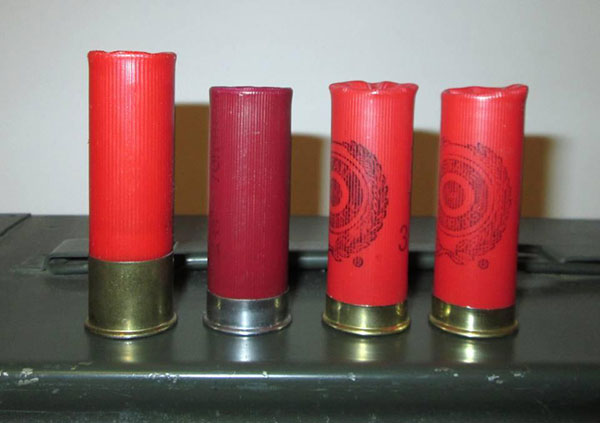
Some of the shells used to test the sensitivity of the Vang Comp kit to shell crimp quality. The Vang Comp extension & follower was quite unreliable with all of these, including the two on the left, which are some of my own handloads that function fine in my other magazine extensions.
The excessive gap in the base of the extension and the tilt-prone geometry of the follower I discussed earlier are clearly behind these problems. If you purchase a Vang Comp +2 extension, I would strongly recommend not using the included follower. If nothing else, I’ve found the plastic factory 870 followers to be more reliable in this extension than the Vang Comp part. But if you don’t trust the factory follower, there are plenty of other alternatives – both metal and polymer – that do not feature this troublesome triple-bearing-band design. This still leaves the extension’s wide internal gap though, so whatever follower you choose, make sure to test it for reliable function. I would also avoid under-cap accessories with this extension, as I’ve observed that widening the internal gap increases the likelihood of hang-ups even with improved followers.
The weak Vang Comp magazine spring also caused multiple problems. The first arose during rapid shooting, when I rapidly cycled the action immediately after firing. It was not difficult for me to cycle the action quickly enough that the next shell ended up on the forward shell latch before slide finished its travel and the rear shell latch moved aside, thus failing to feed. Now, a shooter can intentionally replicate this no-feed malfunction even with a heavy magazine spring if they know what they’re doing and are really trying to make the malfunction happen, especially with hard-kicking loads and a full, extended magazine (the more shells in the magazine, the more inertia the spring must overcome). But with the Vang Comp spring, I was able to repeatedly cause no-feeds even with relatively mild (3 DE) target loads, and even with a nearly empty magazine.
While I won’t be worrying about minimizing my split times during a defensive shooting, I do plan on cycling my 870 fast and hard so that it ejects & feeds reliably and is ready to fire again as soon as I’m back on target. I’ve worked to make that a habitual part of my shooting, and I want to have a magazine spring that I can trust to keep up while I’m slamming the slide around in the heat of the moment. For me at least, this spring could not meet that requirement, even in like-new condition.
And then, after running a couple hundred shells in and out of the magazine (between a handful of shooting sessions and many function & capacity tests at home), the spring broke in some more and would no longer reliably feed the last shell in the magazine during fast cycling – even when there was no recoil involved. The shell would still be partially inside the magazine tube when I began to bring the slide back forward, jamming the action when the shell carrier wasn’t able to lift the shell up to the chamber. To clear the jam, I had to bring the slide back again to allow the shell to come the rest of the way out onto the carrier.
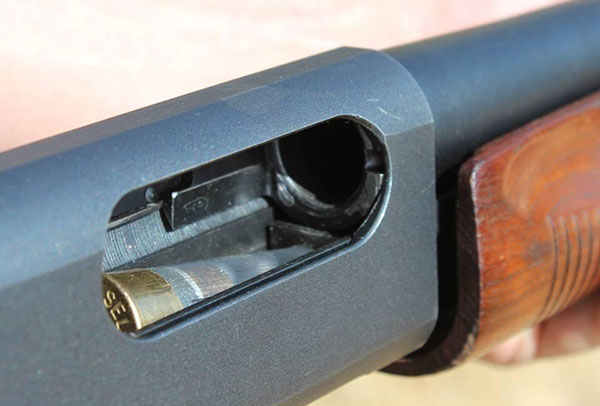
A partial-feed malfunction with a 3” buckshot shell)
While I initially figured this spring might be acceptable for a hunting or recreational shotgun, the fact that I’m experiencing feed malfunctions even when cycling the gun after the recoil event demonstrates that the spring is simply not suitable for use in a +2 extension at all. While all magazine springs will wear out eventually, it should not happen anywhere near this quickly. A very casual shooter might take a while to get through several hundred rounds and start seeing these problems, but that kind of round count is just a function test for a competition shooter or a law enforcement professional. Even a civilian attending a training course can easily go through a couple hundred shells in one weekend.
Another major reliability consideration for any magazine extension is whether or not it can stay in place under recoil. Single-piece extensions tend to be at a bit of a handicap here compared to two-piece designs, as they are generally expected to be able to stay in place without the aid of a clamp.
Shooting both standard 1 1/8-ounce, 1200 FPS (3 DE) target loads and full-power 00 buckshot loads, I tested the Vang Comp +2 with two different barrels; one with a magazine cap detent, the other with no magazine cap detent.
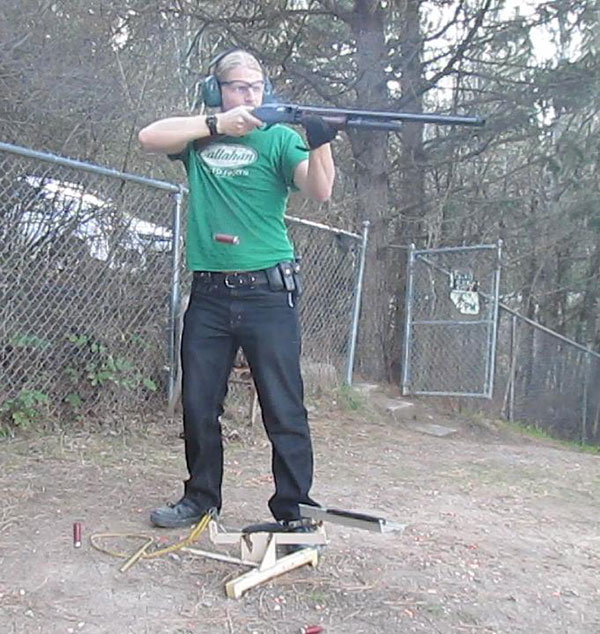
Range testing of the Vang Comp +2 on a barrel without a magazine cap detent
With the detented barrel, the extension did not come loose under recoil after emptying the magazine several times. However, it was noticeably easier to unscrew after the gun had been fired. This suggests that the extension’s engagement with the detent is not entirely positive, and that the extension may eventually work loose during very high-volume shooting. This should not be an issue for most real-world defensive or combat applications, where shootings tend to start and end fast with rarely more than one or two magazine’s worth of shells fired. But during competition shooting, intensive training courses, or law enforcement qualifying sessions where hundreds of shells may be fired in one session, I would recommend checking this extension occasionally and re-tightening it if necessary.
On the barrel without a magazine cap detent, the Vang Comp +2 would not reliably stay put under recoil, and there’s nothing included in the kit to help with this. In a pinch, the extension will probably not launch itself downrange before the magazine runs dry, but if you have a detent-less barrel and want to be able to rely on your shotgun for longer than that, I would highly recommend adding something to positively keep the extension tight. You could have a gunsmith install a magazine cap detent in the barrel guide ring, place a wave washer under the extension, or add a reinforcing clamp. Either way, it’s at least one more extra part you’ll need to make the Vang Comp +2 work reliably.
Conclusions:
Remington 870 Vang Comp Systems Magazine Extension Tube Pros:
• Extremely sturdy all-steel monolithic construction
• Single-piece design simplifies installation & removal
• Sealed end cap prevents ingress of any foreign material from the front end
• Standard 1” outer tube diameter is compatible with many clamp-on accessories
• Sling plate can be reversed, removed, & replaced with basic tools
• +2 with pretty much any SAAMI-compliant 2.75” or 3.5” shells
• Potentially a +3 with the right spring, follower, and/or shells
• Will not extend past any standard barrel longer than 18”, even if under-cap accessories are used
• Sling plate location compatible with any barrel with a muzzle at least 1.2” ahead of the guide ring
Remington 870 Vang Comp Systems Magazine Extension Tube Cons:
• Stainless steel follower is heavy, jam-prone in extensions, and the same color as many shell cups
• Weak magazine spring loses stiffness rapidly with use, and causes multiple different feed malfunctions
• Flat, shallow knurling on extension does not provide much grip
• Excessive internal gap can lead to hang-ups, especially with the included follower
• Use of under-cap accessories can negatively affect reliability
• Extension’s interior is not fully bored-out, limiting capacity & adding extra mass
• Roughly-machined internal tube surface causes noticeable additional drag
• Included sling plate will fit very loosely with most barrels
• Sling plate can only be oriented to the left or right, no vertical option to match the sling studs on most factory stocks
• Ridged cuts at the base are shallow, soft, and do not engage magazine cap detents very positively
• Kit does not include anything to help secure extension on barrels without magazine cap detents
• Light-duty black oxide finish rubs off easily
• Price is high compared to other kits with similar features & functionality, and fixing out-of-the-box issues will require additional effort & expense
It’s not a stretch to say that I was disappointed with the Vang Comp +2 extension kit. While I had had no previous personal experience with Vang Comp extensions or other products, I was well aware of their overwhelmingly positive reputation, and when Vitaly suggested this extension for this review series, I was looking forward to seeing if it lived up to that reputation. But after discovering the cheap finish and rough machining, after having the follower hang up at the range with the very first loading, after pulling the trigger on an empty chamber multiple times while shooting clays, I’ve come to the unavoidable conclusion that this extension does not live up to Vang Comp’s reputation. I think many of the favorable opinions about this kit are made by folks who were impressed by its brand name, and its attractive-sounding features like the stainless steel follower and monolithic construction, but did not actually test their extensions very thoroughly to verify their performance & reliability.
Proponents of the Vang Comp +2 are sure to suggest that I simply got unlucky and received a bad unit. While this might account for some issues like the incomplete boring, rough tube interior, or shallow knurling; other problems like the less-than-positive detent engagement ridges, wide internal gap, and loose sling plate are clearly design flaws. It’s a shame, too. With some quality improvements to the machining and finish, a better thought-out spring & follower, and a handful of minor design tweaks to the extension itself, this kit could be a very good product deserving of its price tag. But as reviewed here, this is simply not the case. If you’re considering this extension, you would almost certainly be better off with one of the many other single-piece +2s on the market. The Wilson Combat +2 extension kits I reviewed previously offer essentially the same functionality as the Vang Comp +2, but they have a more reliable tube interface, a combat-ready spring & follower, much better knurling, a wave washer for use with non-detented barrels, a higher-end Parkerized finish, and a significantly lower price tag.
If you’re already committed to the Vang Comp though, its function can be made acceptably reliable with a replacement spring & follower, and there are a number of options for keeping it in place under recoil. That more or less takes care of the major issues. More minor things like the light-duty finish are also addressable if desired, and improved sling plates are easy to make if you or a friend have access to the right tools. Thanks to this extension’s monolithic construction, a bit of lathe work could even take care of its extra weight and limited capacity. In fact, if you’re a tinkerer with a machine shop at your disposal, a Vang Comp extension might actually be a good starting point for some serious customizing.
But for most folks, unless you get a really good deal on it, I don’t see much of a reason to pay out for a Vang Comp +2 kit – and then spend even more time and money getting it to run reliably – when you could get something better for the same price or less.
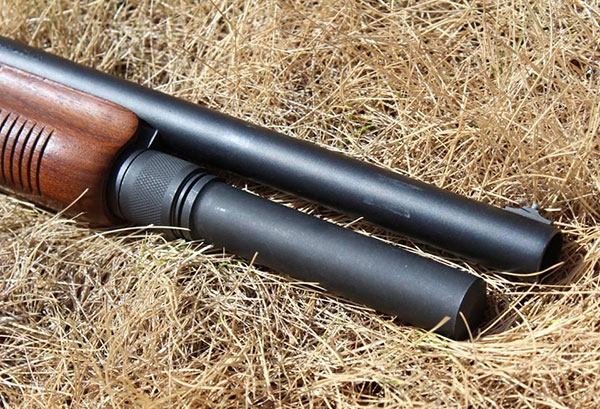
Remington 870 Vang Comp Systems Magazine Extension Tube Review
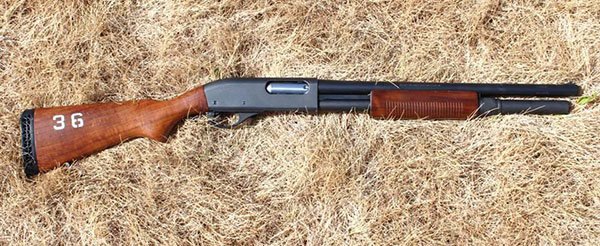
Remington 870 Vang Comp Systems Magazine Extension Tube Review
-Synchronizor
| Get Remington 870 Magazine Extension on Brownells |
Related Posts:
Magazine Extensions for Remington 870 Shotgun (Nordic Components, Choate, TacStar, Remington, ATI)


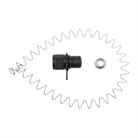
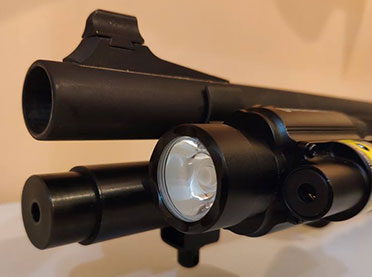
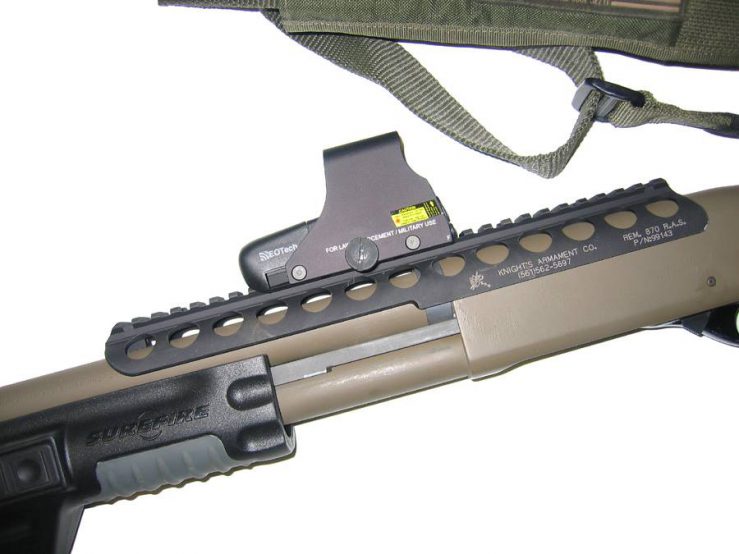
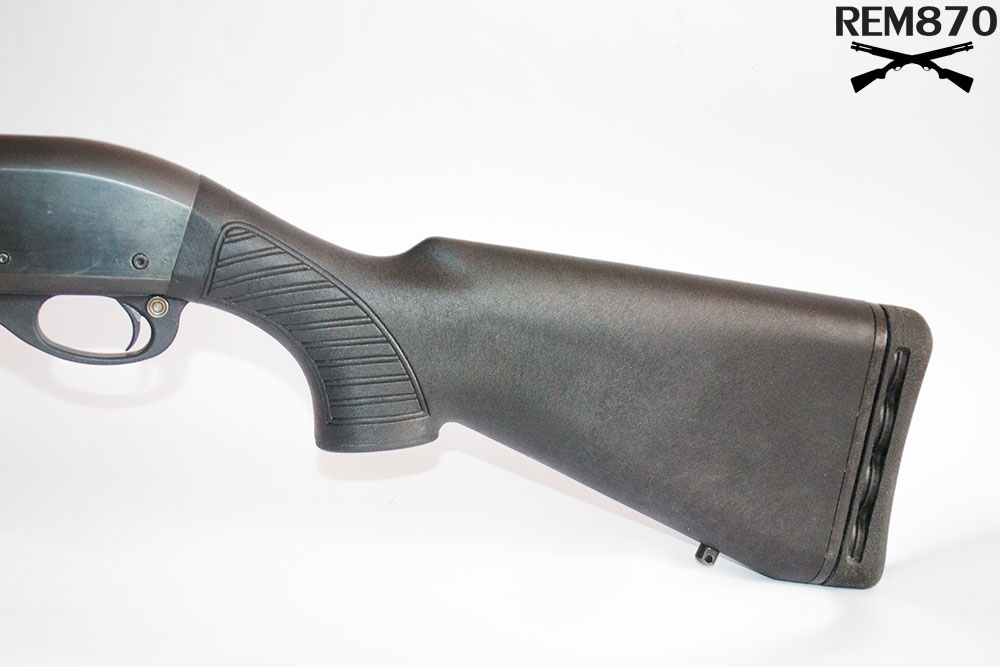
I’ve got to compliment Rem870.com for its thoughtful, sometimes exhaustive, and highly informative content. I’ve learned a lot from this site. This particular review of the Vang Comp system got me really depressed the first time I read it. The descriptions and graphics used to illustrate points the author was making are superb. This person did his homework and spent a ton of time creating or finding excellent graphics to assist with communicating the points he wanted to make. This was one hell of an exhaustive review. Or…so I thought at first.
Something still didn’t seem right so I waited a while and read the post again and a picture of the post emerged. The “something still didn’t seem right” part is that the descriptions and content in the post don’t match the reality in the real world as viewed by my own eyes and experiences along with my knowledge of the industry.
I am an aerospace engineer that has worked on rotary wing combat aircraft that have flown in combat in some very hot, dusty, and otherwise nasty areas. One aircraft I participated in design and flight test on was a clean sheet design and has flown uncounted combat missions in the middle east. I took pieces of this aircraft to NASA for testing and worked experimental flight test before and after the aircraft actually flew for the first time.
My comments on this post will be from an engineer who loves to shoot shotguns.
Here is what the review looked like to me. When I say “looked like” I am talking about overall tone, topics, and the tone presenting any specific topic.
This entire post had the tone of a group of engineers drinking coffee in the breakroom or drinking beers at happy hour having a theoretical discussion on why a specific design can or cannot work, should or should not work, will or will not work, or did or did not work. Looking at the physics and math of [fill in the blank] design this thing can’t possibly work….except in the real world it does work and it’s nearly bullet proof and if it uses Noroc armor then it is bullet proof up to and including a 20mm round.
The post had the engineering equivalent of ESPN fantasy baseball except this was fantasy engineering with a gloomy outlook as if delivered by Lurch of the Aadams Family for why the magazine extension is a bad design and low consumer value. That’s the low end of sophisticated. At the high end of sophisticated the review could be a hit piece by one of Vang’s competitors who has meticulously nitpicked every piece of the engineering design and is relying on the lack of engineering and industry background of readers. Was this a sophisticated hit piece by a determined competitor directed at low information readers? It very well could be. Obfuscation with impressive oratory and graphics camouflages flawed analysis.
The real world looks like this:
* Vang Comp is the only Remington authorized repair facility for the Police line of shotguns outside of the factory itself. The Police line of 870s that are sent for warranty repair are sent to Vang Comp. I didn’t hear this from Vang Comp, I heard this from Remington. “Heard” is not a rumor, it’s an executive management human voice at Remington speaking and my ears heard them speak. Consumer products are sent elsewhere but the mission critical stuff goes to Vang.
* Police departments all over the world use Vang Comp configured guns. They contract with Vang Comp and the guns are produced in Vang’s shop. I think we all can agree that a shotgun in a police vehicle is a mission critical piece of equipment that has to work every time.
* Travis and Chris both use Vang Comp modified guns (Nighthawk Custom) in Magpul’s Art of the Dynamic Shotgun circa 2009.
* The very expensive Nighthawk Custom guns are Vang Comp guns at their base or use Vang Comp components.
* The Express line of shotguns from Remington is not as well designed and manufactured as the Police line. We’ve all seen that. Remington also admits this fact. The president of Remington was recently relieved of duty because of Remington’s poor quality problems over the last decade or so. I have an 870 Magpul Tactical that is so poorly made that it is best used as a club because it can’t hit a bad guy at 15 yards with buckshot. $700+ bucks down the crapper with this PoS gun. Can’t say that about my two 870P’s, it’s hard to miss with those.
As an engineer I could pick this review apart word-by-word, sentence-by-sentence, paragraph-by-paragraph just as the author did with the minutia and details of the Vang Comp components being reviewed. My dissection of the review would necessarily need to be 3x or 4x the size of the review itself because of all of the background and explanation required to point out the flaws.
Instead I’ll just nitpick at one section that is representative of all of the other sections. All of the other sections will suffer the same problem to some degree.
The section critiqued is the range test section toward the end. The author engaged in engineering fantasy baseball, expected that parts is parts, that one size should fits all dammit! and fails to communicate that different models of Remington shotguns are both built and sized differently because the guns have a different purpose.
The executive brief on the author’s review follows this PATTERN of THINKING:
* Parts is parts and the author is expecting parts to fit parts.
* These Jeep parts don’t fit or work well on my Dodge Charger. They are both Chrysler vehicles. Chrysler sucks, what’s their problem, Chrysler parts are no good. (pattern of thinking)
(PATTERN of THINKING) This Vang Comp magazine extension kit is for the Remington 870. Vang parts should fit Remington 870 parts. Right!? Damn right they should! Conclusion Vang Comp is not a good deal unless you are really Jones’n for it.
What’s Wrong?
The author makes an assumption that all Remington 870 shotguns are made the same. Same magazine tube. Same barrel with detent. Same barrel diameter and other dimensions. Same ______ (you get the picture). The author is enthralled with a fantasy baseball-esque engineering analysis complete with diagrams showing angles of incidence and attack for specific parts that he fails to see the real world while making major mistakes in his assumptions.
Vang Comp parts are made by the best in the world for use by the best in the world. And, the previous statement is repeatedly proven by the best in the world every day. Vang Comp parts are not made for a sporting shotgun without detent on the barrel, for example.
Shotgun class at Gunsite is a great place to see if your shotgun, kit, and skills work. I’ve seen shooters with recoil-caused hematoma from the neck area just below the ear down to the elbow. I’ve seen and experienced failures in kit mounted on a belt or other type of body-attached harness or rig. What I haven’t seen is a Vang Comp modified gun fail during class. I haven’t seen guns with Vang Comp components jam or fail during class. I certainly haven’t seen any of the failures the author estimated that could occur from the design critique of this review.
I’ll also note that Vang Comp is literally down the street from Gunsite so there are a lot of Vang Comp guns in shotgun classes there. 50% of the guns in a class could be Vang Comp is not a stretch. If something breaks on a Vang Comp gun or a gun with Vang Comp parts breaks, one phone call and Vang Comp would be up the hill in no time flat to see for themselves and fix the problem on the spot. I’ve not seen the need for that to happen.
“Shooting both standard 1 1/8-ounce, 1200 FPS (3 DE) target loads and full-power 00 buckshot loads, I tested the Vang Comp +2 with two different barrels; one with a magazine cap detent, the other with no magazine cap detent.”
Sounds like a fair test but not enough information is communicated. What are the barrels? Barrels for an 870P mounted to an actual 870P? Barrels for an 870 Express (any flavor) mounted to an 870 Express receiver with an Express magazine tube? (My 870 Magpul Tactical, now a club, had a manufacturing defect in the magazine tube). The photograph looks like a low end 870 Wingmaster. Parts ain’t parts here. 870 Express stuff has been crap for about 10 years, Remington admits it and the president of Remington lost his job because the company went into the tank from quality problems.
“With the detented barrel, the extension did not come loose under recoil after emptying the magazine several times. However, it was noticeably easier to unscrew after the gun had been fired. This suggests that the extension’s engagement with the detent is not entirely positive, and that the extension may eventually work loose during very high-volume shooting.”
That’s a fair statement and conclusion. We still don’t know what barrel was used – Police (outstanding) or Express (been crap lately) to know if the detent is the problem. As we’ll see below, I’ve seen and done the high volume shooting so I don’t have to imagine “that the extension may eventually work loose during very high-volume shooting.” I’ve been there and seen that and have the answer, no imagination required. Remember when I mentioned “fantasy engineering?” The author guesses or estimates “that the extension may eventually work loose during very high-volume shooting” as opposed to having actually done high-volume shooting with this rig. Guessing something might happen is not a review. Reporting the results after high-volume shooting is a review. Re-read the paragraph above where I discuss fantasy designs that can’t work but are bullet proof in real life. That’s what the author has done here.
The whole review suffers from the fantasy engineering problem. Here’s the design aspect, here’s what bad things could happen. It’s starting to look like engineers at happy hour. Where are the real world stories of hard use and abuse?
“But during competition shooting, intensive training courses, or law enforcement qualifying sessions where hundreds of shells may be fired in one session, I would recommend checking this extension occasionally and re-tightening it if necessary.”
I can’t speak to competition but I can speak to intensive training courses where hundreds of shells have actually been fired in real life. If your gun can get through a 1-week shotgun class at Gunsite then you know it is reliable. As stated above, I’ve never seen a Vang Comp gun or gun with Vang Comp parts fail at Gunsite. (Just because I haven’t seen it doesn’t mean it hasn’t happened, it just means I have not personally seen it, but at least I’ve been there and done/seen that and can speak to it). I haven’t seen people with Vang Comp guns tightening their extensions nor have I heard them complain about loose extensions. Gunsite is rough and will break your gun, will break your kit, and will break you if there are weak points. Makes me wonder what the reviewed did or did not do to prepare these guns for testing. Malfunction aft of the recoil pad during assembly? Potentially.
The author’s advice is good advice but it’s fantasy advice from someone that didn’t test this gun under an intensive training course, LE qualification or competition. The author is giving advice like “always check the air in the tires” or really old school “always check the water level in the battery and refill with distilled water if necessary before any long road trip.” Why am I getting this advice? Do I have bad tires? What’s the deal with this crappy battery? I’m scared to take the road trip now because of what can go wrong. Better stay home safe and sound.
It’s just good advice that sounds like the Vang Comp extension may have a problem when in fact there is no problem. It sounds ominous and failure prone when the author recommends “checking this extension occasionally and re-tightening it if necessary” as if bad things happen on a regular basis.
I can say this about tightening something that shakes loose during “intensive training courses.” I have a Mesa Tactical collapsible stock on an 870P and called Mesa Tactical when I installed the stock to ask if I needed Loctite on the castle nut to avoid the nut coming loose. Note I called them and spoke to a human on the phone. I was told no Loctite was needed. Not believing that for a second I took a castle nut wrench to class just in case and sure enough I had to tighten the castle nut because it came loose…on the first day.
Is the Mesa Tactical stock a piece of crap because the castle nut comes loose during intensive training? Should you not buy one because I had a real problem at a real training class? That’s your call. I love that stock and will simply keep the castle nut wrench handy and maybe start using blue Loctite. The only way to do a full take-down cleaning is to remove the stock which is why the castle nut is not staked or Loctited. You have to know your equipment and its limitations.
“On the barrel without a magazine cap detent, the Vang Comp +2 would not reliably stay put under recoil, and there’s nothing included in the kit to help with this.”
Parts ain’t parts and the author is expecting parts is parts. This is a malfunction aft of the recoil pad and is flat out putting the wrong parts on the wrong gun. Know your weapon. Know its limitations. The author wants to put this extension on a gun the extension is not designed to fit. Then the author dings Vang Comp for not having some extra parts to make the extension fit a gun the extension is not designed to fit. This Jeep part doesn’t fit or work well on my Dodge Charger. These are both Chrysler products, what is the problem at Chrysler? Chrysler sucks. Wrong part on the wrong gun is not a problem with Vang Comp. It’s a problem with the user.
Vang Comp products are duty use and/or tactical products more than sporting products. What the author needs to do is get out of the fantasy engineering world that is the bulk of this review, build up an 870 with Vang Comp parts and use a real 870P or Wingmaster receiver with internals, understand the barrel profile (outside diameter, detent, etc.), then go take a 1-week shotgun class at Gunsite (it’s actually 2 classes 260 Shotgun and 270 Shotgun in one week).
In doing that class with his build and his gun fails while other Vang Comp guns do not then the author needs to ask himself what he did wrong. Vang Comp guns and guns built with Vang Comp components are as tough, durable, and reliable as it gets. Remington itself farms out work to Vang and Vang Comp is the only place warranty work on the Police line is perform outside of the factory itself. Police departments and military units rely on Vang to build an excellent “tool” for them to use in life and death situations. That’s real world. This review gives the exact opposite impression, something is wrong with that.
Epilog
Quoting the author “If you’re already committed to the Vang Comp though, its function can be made acceptably reliable with a replacement spring & follower, and there are a number of options for keeping it in place under recoil.”
If you have to work to make a Vang Comp extension and follower to function work reliably then you have misunderstood your weapon or have done something wrong. You are trying to put the wrong parts on the wrong gun. Know our weapon.
Ask yourself this: Which has the better chance of being broken, a) the Vang Comp magazine extension system trusted and proven by tactical teams the world over for decades or b) the hand loads of somebody doing a review on the Internet. The reviewer chooses answer a) as being broken because it cannot be b). The whole review is full of this type of analysis..
One thing I want to make very clear is that I had no motive for writing this piece beyond simply evaluating a product for the benefit of those considering using it. No attempt was made here to obfuscate anything about my experiences & observations. Going in, I honestly wanted to like this extension. Unlike some accessories, extensions have real purpose for a number of shotgunning applications, and the more good options there are out there, the better. This isn’t a “hit piece”, I have nothing against Vang Comp; many folks have had good things to say about them, but having never had any business with them, I’m in no position to agree or disagree. In any case, the quality of their other products and services has no bearing on the extension kit that’s currently sitting in a box in my house. Even if they had previously worked on my shotgun until it could produce 3” buckshot patterns at 100 yards with no recoil, my evaluation of this extension kit would have been exactly the same.
You claim I’m using engineering double-talk to try to distract & confuse readers. Quite the opposite in fact, my goal was to make things as clear as possible, especially for those who do not share my background. Reporting when something works as advertised is easy; when something isn’t working right, I want to be able to explain exactly why, for everyone’s benefit. If you or anyone else was confused by something in this review, I would be very happy to try and clear things up.
You also seem to think I sat this extension on a table, stared at it for a while, and tried to imagine what could go wrong with it. I’m an engineer myself, and I abhor that approach, as it never provides a clear picture of a design’s weaknesses. If I want to know how something might fail, I go out and use it until it fails. When I needed to design a heat/splash shield for a casting pit lamp, I grabbed a plasma cutter and a glass scoring tool, made a prototype, and dumped a crucible of molten aluminum on it to see what would happen. When I was evaluating the Vang Comp +2, I spent 8 months shooting with it, testing its function, and examining how all the parts interacted. Everything I found wrong with this extension, I found as a result of using it. All of my conclusions came from focused investigation and logical evaluation of those experiences.
Problem: the follower kept jamming during loading and feeding. Investigation: measuring the depth at which the jams occurred revealed that the follower was snagging at the internal joint between the magazine tube and extension. Logical evaluation: changing the follower – while keeping everything else the same – reduced the jamming significantly; and installing the follower in other extensions that had previously been reliable resulted in the same sort of hang-ups. Conclusion: the follower is interacting with tube joints in a way other types of followers aren’t.
Problem: I was getting partial- & non-feed malfunctions during rapid cycling. Investigation: measurements showed that the spring was significantly weaker than other factory & aftermarket magazine springs. Logical evaluation: installing longer springs from other +2 extension kits – while keeping everything else the same – solved the problem. Conclusion: the spring is underpowered for this application.
Problem: the finish was wearing down to bare metal all over the place. Investigation: digging into the product details on Vang Comp’s site revealed that the extension had a black oxide finish, not Parkerizing as I had assumed. Logical evaluation: Vang Comp has the capabilities to finish firearms & parts with a number of more durable treatments, including Parkerizing and Cerakoting. Conclusion: corners were cut on the extension’s finish.
These and others are real – not imagined – problems that I personally encountered while using this extension. Maybe my shooting isn’t as hardcore as yours, but it doesn’t matter. If the spring is too weak to feed shells at my local range, it’ll certainly do no better at an expensive training course that I couldn’t afford anyway. The same goes for the function of the follower, or the durability of the finish, or the engagement of the detent ridges, or the fit of the sling plate, or the weight & limited capacity of the tube. If ya can’t dodge a ball, you can’t dodge a wrench.
Now, as for specific items you call out:
Expecting a part to fit both Express & Police 870s is not like your example of expecting Jeep parts to fit a Dodge; it’s like expecting an oil filter for a 1998 Jeep Grand Cherokee Laredo with a four-liter straight-six to fit a 1998 Jeep Grand Cherokee Limited with a four-liter straight-six. You can argue quality differences all you want, but if you know anything about 870s, you should at least be aware that the different 870 lines use the same design. Specifically, the length of the magazine tube, the geometry of the threads on the end, and the location of the barrel guide ring are identical among all standard 12ga 870s made today. Having a black oxide finish instead of Parkerizing will not suddenly throw something as mechanically straightforward as a magazine extension completely out of whack. I tested this extension with three different barrels and two different magazine tubes, and observed the same problems with all of them. I also collected measurements from many other 870s – even some 870 clones – so that I could take dimensional variations into account in my testing. Furthermore, my 870 & its various barrels function just fine with other extensions.
The possibility of the extension coming loose with the detented barrel is not me imagining things. I tightened the extension down as hard as I could before firing, and afterward, it came off with next to no effort, despite the barrel heating up in the meantime. No, the barrel wasn’t loose and rattling around, but the extension had clearly backed itself off. You claim that checking and re-tightening is common sense, but I have other extensions and magazine caps that engage the detents properly, and I trust them not to back off on me, even after hundreds of rounds fired. As for testing on a barrel without a magazine cap detent; you may stick up your nose at civilian 870s, but there are millions of them out there, and it behooves me to discuss how this product performs on those guns. Noting that additional parts will be required to make this extension reliable with a non-detented barrel is relevant consumer advice, plain and simple.
You also claimed my handloads contributed to my problems. First off, I didn’t shoot a single handload while testing this extension, all of the live-fire stuff and nearly all of the at-home function tests were with factory loads. The only thing I did with handloads was investigate how crimp quality affected the frequency of the problems that I had already observed with factory ammo. Second, if you can imagine how handloads would weaken a spring or shake an extension loose while factory loads with the same mass & recoil wouldn’t, I would love to hear about it.
I’ll end by reminding you that, as with most reviews, this piece has a sample size of one. Maybe I just got unlucky and got the one reject that Vang Comp ever shipped out. Maybe some wet-behind-the-ears machinist didn’t zero their lathe properly. Maybe the person doing the knurling wasn’t paying attention. Maybe a magazine spring from the +1 bin got knocked into the +2 bin and the individual assembling the kits was too hung-over to notice. I doubt it, but it is a possibility. I’m also not saying anything against Vang Comp’s other products and services. All I can report are my experiences with and impressions of this one kit, and that’s what I have done here, honestly, objectively, thoroughly, without agenda, and to the best of my ability.
Very well put, Synchronizor. I’m impressed at how well you keep your composure really; personally I had to take two smoke breaks to finish wading through that codswallop and not because I’m a slow-reading chain smoker. When I reached the first use of that terrible Jeep/Dodge metaphor I cursed at my monitor loud enough to both wake and scare the hell out of my dog. Big fan of the website by the way; found it a couple weeks ago when I was researching barrels and just what those real short ones without any ribbing are good for.
TC – you’re a blatant shill, your arguments resemble those of an uneducated and financially struggling middle-aged gypsy woman during her time of the month, and I’d be surprised to learn that you’ve ever ‘engineered’ anything more sophisticated than a too-much-cheap-beer-and-taco-bell hangover shit. I award you no points, and may John Moses Browning have mercy on your soul.
Synchronizor – Awesome review man, although also disappointing, as I just ordered this extension, and now I’m already looking for another follower.
Don’t worry about TC. Honestly, I’m having trouble believing his credentials he thought were so important. I also think he has a complex about the word “fantasy.”
I agree with you completely here.
“…it’s like expecting an oil filter for a 1998 Jeep Grand Cherokee Laredo with a four-liter straight-six to fit a 1998 Jeep Grand Cherokee Limited with a four-liter straight-six…”
I understand what TC meant about VC gauges never failing at Gunsite, but he never acknowledged that there is a difference between a VC gun, done by VC, and someone buying the extension, and slapping it into an 870 without specialized fitting (which was the context of your review).
Anyhow, I felt really bad reading his comment. This is one of the best product reviews I have ever read. Like ever.
WOW..All I can say is “What a kick ass review and the comments were even more kick ass” WOW!!!…
I’m new to Rem870.com, so my reply comes late. Nonetheless, after reading the review and TC’s own reply, I just wanted to offer my humble commentary. As my British colleagues in ME would say re TC’s reply, “what a load of old bollocks.”
Entirely ad personam, self congratulatory (“I’m an aerospace engineer”,) smug belittling of a colleague (unless you don’t believe that synchronizor actually IS an engineer,) anecdotal referencing (rather odd coming from an engineer,) technically incorrect staments (again rather odd coming from an engineer,) stupid analogies-truly stupid analogies…TC could simply have responded to the issues enumerated by Synchronizor in the section “Remington 870 Vang Comp Systems Magazine Extension Tube Cons” and not have to spend the inordinate reply times mentioned as excuse for not dissecting the review. No, it’s better to insult with fantasy baseball or beer drinking memes. Not a gentleman, this TC. Unless he replies ad argumentum convincingly, I remain swayed by Synchronizor’s review. Excellent job, my man.
I have a Remington 1100 Magnum 20 gauge with a two shot magazine extension. For some reason the magazine feed hangs up after a shot or two. I think the follower is what is hanging up on the extension connection gap. The person that added the extension years ago failed to return the stock spring and follower so I can’t revert to the stock configuration without getting a stock spring. In the alternative if I could get a follower that would “jump” the extension connection gap, I think the extension would work. Remington is apparently out of business so I can’t get parts from them. Does anyone have any suggestions?